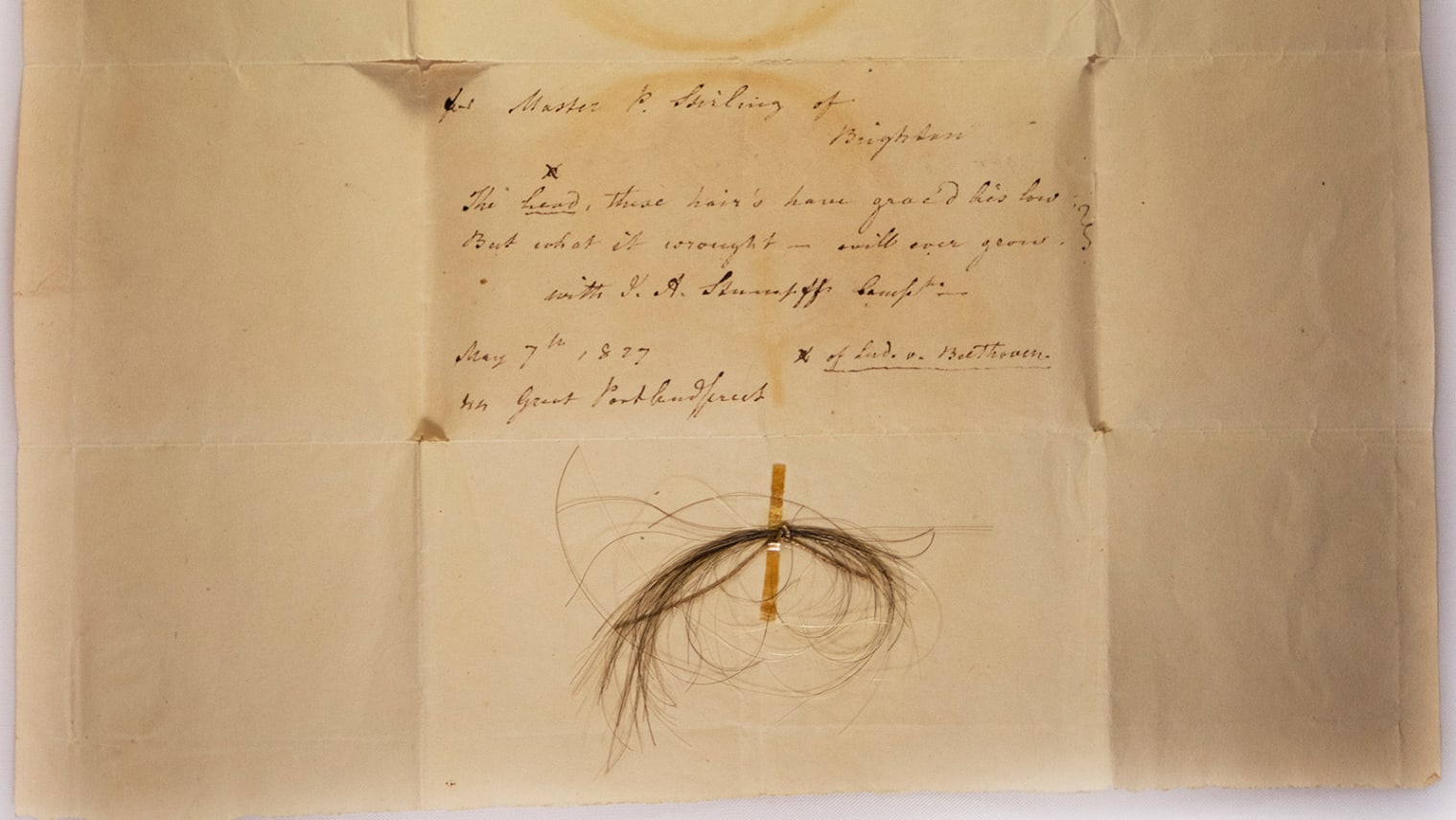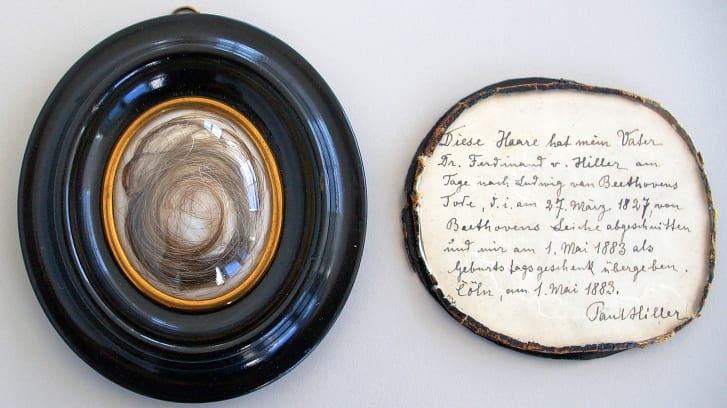Locks of Beethoven’s hair reveal secret family history and health issues
Published 22nd March 2023
Click HERE for a link to the original article.

Credit: Kevin Brown

Locks of Beethoven’s hair reveal secret family history and health issues
Before composer Ludwig van Beethoven died on March 27, 1827, it was his wish that his ailments be studied and shared so “as far as possible at least the world will be reconciled to me after my death.”
Now, researchers have taken steps to partially honor that request by analyzing Beethoven’s DNA from preserved locks of his hair and sequencing the composer’s genome for the first time.
A study detailing the findings published Wednesday in the journal Current Biology.

A portrait of Beethoven by Joseph Karl Stieler was completed in 1820. Credit: Beethoven-Haus Bonn
“Our primary goal was to shed light on Beethoven’s health problems, which famously include progressive hearing loss, beginning in his mid- to late-20s and eventually leading to him being functionally deaf by 1818,” said study coauthor Johannes Krause, a professor at the Max Planck Institute for Evolutionary Anthropology in Leipzig, Germany, in a statement.
The five hair samples helped scientists discover insights about family history, chronic health problems and what might have contributed to his death at the age of 56.
Beethoven’s maladies
In addition to hearing loss, the famed classical composer had recurring gastrointestinal complaints throughout his life, as well as severe liver disease.
Beethoven wrote a letter to his brothers in 1802 asking that his doctor, Johann Adam Schmidt, determine and share the nature of his “illness” once Beethoven died. The letter is known as the Heiligenstadt Testament.

The Moscheles Lock, authenticated by the study, includes an inscription by former owner Ignaz Moscheles. Credit: Ira F. Brilliant Center for Beethoven Studies/San Jose State University
But Beethoven outlived his favorite doctor by 18 years, and after the composer died, the testament was discovered in a hidden compartment in his writing desk. In the letter, Beethoven admitted how hopeless he felt as a music composer struggling with hearing loss, but his work kept him from taking his own life. He said he didn’t want to leave ”before I had produced all the works that I felt the urge to compose.”
Since his death, questions have swirled around what ailed Beethoven and his true cause of death. Within the last seven years of his life, the composer experienced at least two attacks of jaundice, which is associated with liver disease, leading to the general belief that he died from cirrhosis.
Medical biographers have since combed through Beethoven’s letters and diaries, as well as his autopsy, notes from his physicians, and even notes taken when his body was exhumed twice in 1863 and 1888, with the hopes of piecing together his complicated medical history.
But the researchers behind the new study took things a step further about eight years ago when they set out to do a genetic analysis of Beethoven’s hair. The samples they used included hair cut from his head in the seven years prior to his death.
Genetic revelations
The team started by analyzing a total of eight hair samples from public and private collections across the UK, Europe and the US. During their authentication work, they discovered that two didn’t come from Beethoven at all, while another was too damaged to analyze.

These two locks of hair, including one delivered to pianist Anton Halm by Beethoven, were both authenticated by the study. Credit: Kevin Brown
Previous work suggesting that Beethoven had lead poisoning was determined to be based on a hair sample that didn’t belong to him — one that instead had belonged to a woman.
But five of the samples all came from the same European male and matched his German ancestry. Beethoven had hand delivered one of the locks himself to the pianist Anton Halm in April 1826, saying “Das sind meine Haare!” (“That is my hair!”)
The genetic analysis spotted clues hiding in the composer’s DNA that could add context to his health issues.
“We were unable to find a definitive cause for Beethoven’s deafness or gastrointestinal problems,” Krause said.
“However, we did discover a number of significant genetic risk factors for liver disease,” he added. “We also found evidence of an infection with hepatitis B virus in at latest the months before the composer’s final illness. Those likely contributed to his death.”

Labwork on the Moscheles Lock was conducted at the University of Tübingen in Germany. Credit: Susanna Sabin
Beethoven’s genetic data also helped the researchers rule out other potential causes of his ailments, such as celiac disease, an autoimmune condition, lactose intolerance or irritable bowel syndrome.
Letters written by Beethoven, as well as those of his friends, show that the composer regularly consumed alcohol. Although it’s difficult to tell how much he drank, a close friend wrote that Beethoven had at least a liter of wine with lunch each day.
Drinking alcohol, combined with genetic risk factors for liver disease and his hepatitis B infection, might have been the perfect storm for Beethoven’s health near the end of his life.
“If his alcohol consumption was sufficiently heavy over a long enough period of time, the interaction with his genetic risk factors presents one possible explanation for his cirrhosis,” said lead study author Tristan Begg, Ph.D. student at the University of Cambridge.
But the researchers cautioned that the timing of all of these events was critical to understanding what contributed to Beethoven’s death. Future research could reveal more insights — including the reason behind his hearing loss, the authors said.

The researchers determined that the Hiller Lock, long attributed to Beethoven, was actually a hair sample from a woman. Credit: William Meredith
“We hope that by making Beethoven’s genome publicly available for researchers, and perhaps adding further authenticated locks to the initial chronological series, remaining questions about his health and genealogy can someday be answered,” Begg said.
A secret in the DNA
Once the research team established Beethoven’s genetic profile, they compared it with the DNA of his living relatives in Belgium. But in a twist, they weren’t able to determine a complete match.
While some of the relatives shared a paternal ancestor through Beethoven’s family in the late 1500s and early 1600s, there was no match for the Y-chromosome in Beethoven’s hair samples.
This suggests that somewhere in the family’s history, there was an extramarital affair on Beethoven’s father’s side that resulted in a child.
“Through the combination of DNA data and archival documents, we were able to observe a discrepancy between Ludwig van Beethoven’s legal and biological genealogy,” said study coauthor Maarten Larmuseau, a genetic genealogist at the KU Leuven in Belgium.
The researchers think the affair occurred sometime between the 1572 conception of Hendrik van Beethoven, an ancestor in the paternal Beethoven line seven generations removed from the composer, and the conception of Beethoven in 1770.
